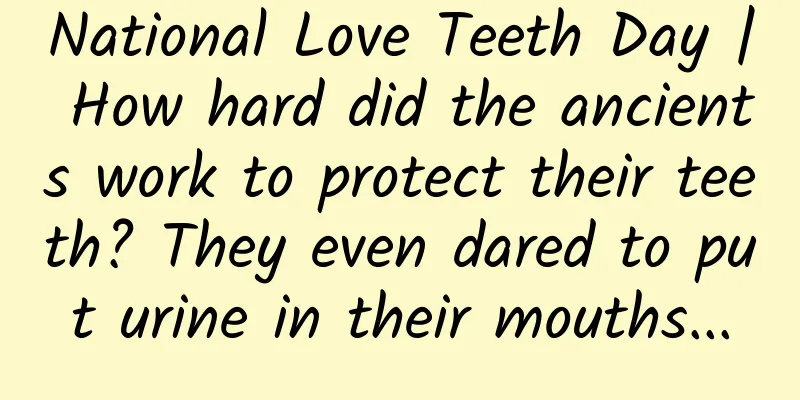National Love Teeth Day | How hard did the ancients work to protect their teeth? They even dared to put urine in their mouths...

|
September 20 is National Love Teeth Day. You must be familiar with modern tools for cleaning teeth, but do you know how many strange ways of cleaning teeth there were in ancient times? Willow branches, eggshells, and even urine were put into the mouth. It looks really unique (sang) (xin) (bing) (kuang) (, let’s take a look with Tadpole!) Protect your teeth, see how the ancients did it Since the Qin and Han Dynasties, successive dynasties have been deeply influenced by the Zhou Dynasty's etiquette. The Book of Rites once recorded that "when the cock first crows, rinse your mouth with salt water", which means that when the cock crows, everyone should rinse their mouths and clean their teeth. It can be seen that as early as the Zhou Dynasty, my country had already had the habit of rinsing its mouth. The Sui Dynasty's Treatise on the Causes and Symptoms of Various Diseases also said, "After eating, you should rinse your mouth several times. Otherwise, you will get tooth decay." After eating, you should rinse your mouth several times. If you don't, you will get tooth decay. It can be seen that our ancestors have attached great importance to protecting teeth since ancient times. In the Tang Dynasty's Prescriptions for Emergencies, Sun Simiao recorded, "Every morning, put a pinch of salt in your mouth, hold it in warm water, and brush your teeth." "Brushing teeth" means brushing teeth. In "A Dream of Red Mansions," Jia Baoyu has the habit of brushing his teeth with salt every morning. The "tooth brushing method" originated from ancient India. According to legend, when Sakyamuni was preaching under the Bodhi tree, the disciples around him had serious bad breath. So Sakyamuni began to persuade people to pay attention to cleaning their teeth and taught his disciples how to make toothbrushes with tree branches. Later, as Buddhism was introduced to China, the "tooth brushing method" was also introduced to China. In addition to using fingers to "brush teeth", the willow twig toothbrush, which was widely used by civilians in the late Tang Dynasty, was easy to obtain and economical. At that time, "chewing tooth wood in the morning" was popular. Take a section of the willow twig soaked in water and hold it in your mouth to chew. When the willow fiber inside is bitten out, it will become a toothbrush with comb teeth. Such toothbrushes were called "Yangzhi" at that time, which comes from Sanskrit and translates to "tooth wood". Today, there is still a word "Yangzhi" in Japanese, which means toothpick and toothbrush, which should be the name retained in the Tang Dynasty of China. In terms of materials for cleaning teeth, the ancients used salt to brush teeth, which can indeed play a role in sterilization and anti-inflammation, and to a certain extent prevent periodontal disease and gingival bleeding. In 752 AD, Wang Tao's "Wai Tai Mi Yao" also recorded the method of using medicine to clean teeth: take half a liang of Cimicifuga, three fen each of Angelica dahurica, Ligusticum chuanxiong, Asarum sieve, and Agarwood, and six fen of Hanshuishi, and pound and sieve them into powder. Every morning, "bite the willow branches to soften the head, apply medicine to brush the teeth", which can make the teeth "fragrant and smooth". This is also the earliest written record of tooth cleaning and brushing with medicine. Ancient toothbrush, picture source Tencent News Network Today, the earliest existing toothbrushing picture in the world is a mural in the Mogao Grottoes in Dunhuang. This mural is called "The Battle of Radusha", which depicts the scene of the Buddhists defeating the heretics, and the heretics converting, washing their hair, shaving their heads, rinsing their mouths, and brushing their teeth. It is very precious. A partial view of "The Battle of Radusha", picture source: China Gansu Network The willow branch toothbrush of the Tang Dynasty allowed people to take a step further in protecting their teeth. In the Song Dynasty, toothbrushes were called "toothbrushes". Zhou Shouzhong, a Song Dynasty scholar, recorded in "Health Preservation Collection": "Toothbrushes are all made of horsetails." The earliest toothbrush bristles were mostly made of horsetails, more than an inch long, placed on ox horns, and similar in shape to modern toothbrushes. In an ancient tomb dating back to the ninth year of the Yingli period of the Liao Dynasty (959 AD), archaeologists discovered two rows of eight-hole bristle toothbrushes, which were 700 years earlier than the toothbrushes recorded in Europe in 1640. In "Zhengzhi Zhunsheng" (1602 AD) by Wang Kentang of the Ming Dynasty, a variety of medicines such as "Lao Ya San, Bai Ya San, and Musk Toothbrushes" were recorded as "commonly used toothbrushes". From this, it can be seen that people at that time had already done some research on protecting their teeth. Ancient toothbrushes, picture source Tencent News Network Weird ways of cleaning teeth in different countries Not only in China, but also in countries around the world, people have noticed the importance of protecting teeth a long time ago. As early as 5000 BC, Egyptians were already making tooth powder, which included ox hoof powder, myrrh, powdered and burnt eggshells, and pumice. It is speculated that people at that time would use their fingers as tooth sticks (the predecessor of toothbrushes, there were no toothbrushes at that time) to rub tooth powder on their teeth to clean them. Later, the Greeks and Romans improved the formula of tooth powder. They added some materials such as broken bones and oyster shells to remove dirt from teeth. The Romans added charcoal powder, bark powder, and more flavorings to improve the smell, which is very close to modern toothpaste. In addition to applying tooth powder, the ancients had a more unique way to clean their teeth. In ancient Rome, people firmly believed that urine could be used to clean teeth. Every morning and evening, they would hold a mouthful of urine in their mouths and spit it out after a few minutes. The Romans also had their own unique understanding of the choice of urine. The Roman nobles believed that among many urines, Spanish urine had the best tooth cleaning effect. At that time, there would always be a large number of ancient Romans waiting at the docks for the fleet to bring back the Spanish urine. The Roman nobles who had the conditions would directly hire a Spanish servant at home, which was convenient and fresh. Although this method seems difficult to accept now, modern medicine believes that urine contains ammonia, and using it to rinse the mouth can indeed play a certain cleaning role. In Europe in the 18th century, there were operations similar to today's teeth cleaning. However, it was not the dentist who cleaned their teeth, but the barber in the barber shop. When cleaning teeth, the customer sits in the chair of the barber shop, opens his mouth, and the barber will use a file to file the customer's teeth little by little. After filing, apply a very corrosive solution to clean it, and finally wipe it clean with a cloth. The method is a bit simple and rough, but it also reveals people's attention to dental care. How to keep a good set of teeth? Nowadays, the concept of oral health has been deeply rooted in people's minds. People are paying more and more attention to oral hygiene and protecting their teeth. So how can we have healthy teeth? Toothbrush and toothpaste, picture from pixabay 1. Correct brushing: Develop the habit of brushing teeth from an early age, brush your teeth once in the morning and evening every day, do not eat after brushing your teeth at night, and do not eat candy, cakes and other desserts before going to bed to reduce the incidence of dental caries. 2. Correct choice of toothbrush: You should choose a toothbrush that suits you, choose different toothbrushes for different age groups, and personal toothbrushes cannot be used in series. The toothbrush should have medium hardness bristles and be replaced every three months. 3. Correct choice of toothpaste: Toothpaste is an auxiliary product for brushing teeth, and you should choose a suitable toothpaste according to your oral condition. 4. Master the correct brushing method: The correct brushing method should be a combination of horizontal brushing and vertical brushing, and clean in different areas to avoid missing. Each brushing must be insisted on for 2-3 minutes, and brush every tooth carefully and meticulously to achieve the purpose of cleaning teeth. 5. Regular check-ups: Regular oral health checks are best done once every six months before the age of 6, and once a year after the age of 6. If conditions permit, regular teeth cleaning is also a good way of protection. Maintain oral health and improve the quality of life. Take care of your teeth and pay more attention to oral health. May you and I have healthy teeth and be happy every day! References: 1. Zhang Lei. Thirty years of bumpy progress in dental prevention and treatment [N]. Health News, 2018-09-27(005). 2. Zhao Wei, Zhao Qi. Overview of dental prevention and treatment in ancient China [J]. Chinese Journal of Medical History, 2009(02):90-92. 3. Zhao Jianxiong, Su Yanling. Contribution of ancient my country to dental prevention and treatment [J]. Journal of Lanzhou Medical College. 1990(16):114-115. Review expert: Lu Bin, Air Force Medical University Stomatological Hospital, Department of Oral and Maxillofacial Surgery, Associate Chief Physician, Associate Professor. Areas of expertise: Diagnosis and treatment of common oral diseases; Sequential treatment of cleft lip and palate; Bone grafting for alveolar cleft. |
>>: Wear masks scientifically to prevent the epidemic
Recommend
4 types of women who may turn into beasts in bed
American sexologist Edward Morley wrote that men ...
How long does it take for a woman's menstruation to end after induced abortion?
Induced labor is a surgical procedure. Many pregn...
How to get rid of stretch marks after childbirth
The birth of every baby is the hope of every fami...
Itchy genitals after moxibustion
Moxibustion has now become a more common Chinese ...
What causes spotting after menopause?
Once women make this decision, the risk of develo...
Can I have an abortion if I get pregnant one year after a caesarean section?
If the contraceptive method is unsuccessful, the ...
The flesh above the cesarean section incision falls
Everyone should be familiar with cesarean section...
Which part is best for moxibustion for uterine cold
Uterine cold refers to a relatively common diseas...
Simple formula reveals osteoporosis risk
This is the 3837th article of Da Yi Xiao Hu 【Behi...
My period has not come yet and I am not pregnant.
Many women often have irregular menstrual periods...
Dietary considerations during menstruation
Many female friends have their period every month...
Magnesium sulfate, a "one-drug-multiple-purposes" drug, is useful for both wet compresses and oral administration
Speaking of magnesium sulfate, I believe that obs...
The water broke at 11 weeks of pregnancy and the fetus was successfully preserved.
I believe that all pregnant women know that in th...
Cervical cytology test results and treatment methods
Cervical problems are a major concern for our fem...
Is it OK to have sex three days after an abortion?
People in life always think about satisfying thei...









